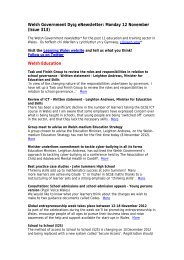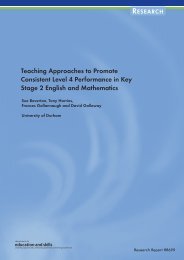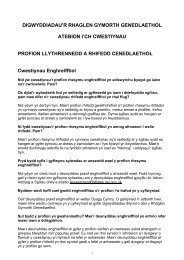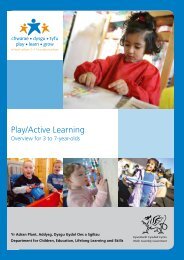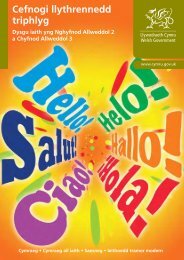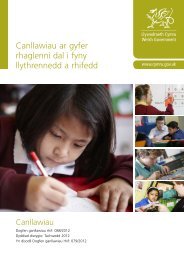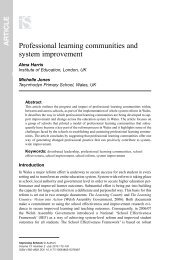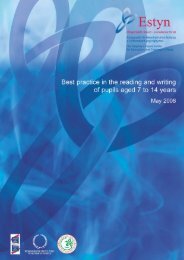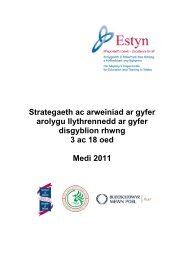Restorative Practice in Schools - Guidance - CfBT
Restorative Practice in Schools - Guidance - CfBT
Restorative Practice in Schools - Guidance - CfBT
- No tags were found...
Create successful ePaper yourself
Turn your PDF publications into a flip-book with our unique Google optimized e-Paper software.
<strong>Restorative</strong> <strong>Practice</strong> <strong>in</strong> <strong>Schools</strong>Executive Summary‘‘Unlike punitiveapproaches, <strong>in</strong>which a third partyacts as judge, juryand executioner,restorative practicepredicates uponownership ofbehaviour andconflict rest<strong>in</strong>gwith those directly<strong>in</strong>volved, who alsoreta<strong>in</strong> responsibilityfor resolutionof the problem.‘‘IntroductionAlthough the use of restorative practice <strong>in</strong>schools is a recent development, it has deephistorical roots. In many ancient societies,<strong>in</strong>clud<strong>in</strong>g the Sumerian and Babylonian,restitution was the cornerstone of the justicesystem. In more modern times, the applicationof the longstand<strong>in</strong>g pr<strong>in</strong>ciples of restorativejustice has been embraced by police forces<strong>in</strong> North America, Australasia and the UK,where the Thames Valley force has been atthe forefront of this development. <strong>Restorative</strong>justice has been applied to a wide range ofsituations by the police, from fairly immediateresponses on the beat to complex reparationof harm <strong>in</strong> the wake of very serious offences.In recent years restorative practice has notbeen conf<strong>in</strong>ed to two-sided offend<strong>in</strong>g, but alsobeen applied <strong>in</strong> the most complex politicaland community contexts. <strong>Restorative</strong> justicewas the basis for the peacemak<strong>in</strong>g processthat ended the civil war of the 1990s <strong>in</strong> theBouga<strong>in</strong>ville Region of Papua New Gu<strong>in</strong>ea.At around the same time <strong>in</strong> South Africa,Desmond Tutu’s Truth & ReconciliationCommision, which sought to repair the rifts<strong>in</strong> South African society at the end of theApartheid era, was <strong>in</strong>formed and largelydriven by restorative pr<strong>in</strong>ciples. Also <strong>in</strong> themid-1990s, follow<strong>in</strong>g the official ceasefire <strong>in</strong>Northern Ireland there was grow<strong>in</strong>g <strong>in</strong>terest <strong>in</strong>develop<strong>in</strong>g non-violent, restorative communityjustice, as an alternative to the cont<strong>in</strong>u<strong>in</strong>guse of punishment beat<strong>in</strong>gs and other acts ofretribution. Despite the complexity and chronicnature of the conflicts, these large-scaleattempts to effect restorative resolution hadsignificant impact.Dur<strong>in</strong>g the last few years, there has beensignificant <strong>in</strong>terest <strong>in</strong> the application ofrestorative justice pr<strong>in</strong>ciples with<strong>in</strong> schools.The restorative practices are based on thenotion that, where conflict occurs, either orboth parties and their relationship are harmedand it is this harm that needs to be addressed.Unlike punitive approaches, <strong>in</strong> which a thirdparty acts as judge, jury and executioner,restorative practice predicates upon ownershipof behaviour and conflict rest<strong>in</strong>g with thosedirectly <strong>in</strong>volved, who also reta<strong>in</strong> responsibilityfor resolution of the problem. This report on<strong>CfBT</strong>’s project <strong>in</strong> East Sussex seeks to <strong>in</strong>formschools on the features of different models ofpractice and guide them <strong>in</strong> the development ofrestorative practice.Key messagesThe establishment of restorative practiceis most effective when it is <strong>in</strong>tegratedwith<strong>in</strong> whole school developmentSuccessful development of restorative practicenot only entails the acquisition of new skillsand techniques but also requires schoolsto reflect on their value base and culture.If restorative approaches are <strong>in</strong>troducedwithout such reflection, they might stillmake a significant difference; however, thatdifference would lack susta<strong>in</strong>ability. <strong>Schools</strong>that periodically revisit and reaffirm their corevalues are best placed to develop restorativepractice. The <strong>in</strong>clusion of reflection on valueswith<strong>in</strong> the process of develop<strong>in</strong>g restorativepractice <strong>in</strong>variably acts as a reassurance thatexist<strong>in</strong>g core values are largely consistent withthe <strong>in</strong>troduction of the new practice.SLT support and <strong>in</strong>volvement isfundamentally importantGiven that restorative approaches challengethe exist<strong>in</strong>g assumptions and practice of atleast some staff, the active <strong>in</strong>volvement of theschool’s senior leaders is essential. The needfor the approach to be championed by oneor more <strong>in</strong>fluential champions has particularrelevance to developments that call for radicalchange <strong>in</strong> policy, procedure and practice.Elements of SLT support that impact on thedevelopment of restorative practice <strong>in</strong>clude:• The headteacher’s participation <strong>in</strong>whole school tra<strong>in</strong><strong>in</strong>g. This has the effectof endors<strong>in</strong>g development; even whereleadership of the project is devolved toanother colleague, the participation of theheadteacher communicates his/her <strong>in</strong>terest,support, commitment and models anopenness to change.www.cfbt.com 5
<strong>Restorative</strong> <strong>Practice</strong> <strong>in</strong> <strong>Schools</strong>Introduction‘‘Dur<strong>in</strong>g thelast few years,there has beensignificant <strong>in</strong>terest<strong>in</strong> the application ofrestorative justicepr<strong>in</strong>ciples with<strong>in</strong>schools.‘‘Pupil behaviour is cited consistently by staff,parents and young people as one of thelead<strong>in</strong>g problems <strong>in</strong> schools. Many of theresponses to unacceptable behaviour can bedescribed as punitive. Indeed, it is common for‘punishment’ to be regarded as a synonym for‘consequences of behaviour’.The impact of punitive approaches is opento question. For example, significant levelsof recidivist behaviour suggest that at leastsome sanctions have little <strong>in</strong>fluence over thesubsequent behaviour of ‘offenders’. Similarly,those schools that make extensive use ofsanctions often cont<strong>in</strong>ue to do so over time,which suggests that punishment has limitedvalue as a deterrent for other pupils. Overall,sanctions-led approaches do little to promoteamong children and young people a genu<strong>in</strong>esense of responsibility for their own behaviour.The restorative alternative is based on thenotion that, where conflict occurs, either orboth parties and their relationship are harmedand it is this harm that needs to be addressed.Unlike punitive approaches, <strong>in</strong> which a thirdparty acts as judge, jury and executioner,restorative practice predicates upon ownershipof behaviour and conflict rest<strong>in</strong>g with thosedirectly <strong>in</strong>volved, who also reta<strong>in</strong> responsibilityfor resolution of the problem.The orig<strong>in</strong>s of restorative practice <strong>in</strong> schoolscan be traced to the response to offend<strong>in</strong>g ofcerta<strong>in</strong> traditional societies, e.g. the Maori ofNew Zealand. A strong sense of communityunderp<strong>in</strong>s this response, <strong>in</strong> which the offenderis exposed to the thoughts and feel<strong>in</strong>gs of thoseaffected by their actions. Typically, this takesplace <strong>in</strong> a large meet<strong>in</strong>g space and a collectiveview of what the offender needs to do to restorehis/her relationship with the community isconstructed. In the process, the responsibilitiesof both the <strong>in</strong>dividual and the community arerefreshed. Although most commonly associatedwith geographically distant societies, features ofthis approach have also been identified with<strong>in</strong>pre-Norman models of justice <strong>in</strong> Brita<strong>in</strong>.In the modern age, the application of theselongstand<strong>in</strong>g pr<strong>in</strong>ciples of restorative justicehas been embraced by police forces <strong>in</strong> NorthAmerica, Australasia and the UK. <strong>Restorative</strong>justice has been applied to a wide range ofsituations by the police, from fairly immediateresponses on the beat to complex reparation ofharm <strong>in</strong> the wake of very serious offences.Dur<strong>in</strong>g the last few years, there has beensignificant <strong>in</strong>terest <strong>in</strong> the application of restorativejustice pr<strong>in</strong>ciples with<strong>in</strong> schools. Despite thefact that central government’s encouragement<strong>in</strong> this area has not been unequivocal – there isscarcely any mention of restorative approaches<strong>in</strong> the Steer report (DCSF 2009) – there is agrow<strong>in</strong>g body of research evidence on theimpact of such approaches (YJB 2004, Allen2006, Kane et al 2006).This report on <strong>CfBT</strong>’s project <strong>in</strong> East Sussex seeksto add to that evidence base and to shed lighton the features of different models of practice.About this reportThis report is based on a research anddevelopment project <strong>in</strong> three schools <strong>in</strong> EastSussex (one secondary, one primary and onespecial). The purpose of the project was to shedlight on the effective establishment of restorativepractice <strong>in</strong> schools. Each school was giventhe opportunity to develop restorative practice<strong>in</strong> a systematic way. Although each schoolwas encouraged to follow its own route on thedevelopment journey, a number of features ofthe project were common to all three: tra<strong>in</strong><strong>in</strong>g <strong>in</strong>restorative practice, support and challenge froma consultant, the gather<strong>in</strong>g of data (on process,perceptions and impact). Preparatory work,<strong>in</strong>clud<strong>in</strong>g brief<strong>in</strong>gs for heads and senior leaders,took place dur<strong>in</strong>g the autumn term 2007, tra<strong>in</strong><strong>in</strong>gwas delivered between January and May 2008and consultants made regular visits to theirallocated schools throughout 2008.The data that was produced by these threeschools has been analysed and presented <strong>in</strong>this report <strong>in</strong> order to <strong>in</strong>form and guide otherschools consider<strong>in</strong>g adopt<strong>in</strong>g a restorativeapproach to behaviour. The report is presented<strong>in</strong> two parts, firstly there is a discussion ofthe ‘core pr<strong>in</strong>ciples’ to be considered whenadopt<strong>in</strong>g restorative practice <strong>in</strong> schools.Secondly there are descriptions of the threeschool case studies. In addition, an abstract oftra<strong>in</strong><strong>in</strong>g materials is provided as an appendix tothis report.www.cfbt.com 7
<strong>Restorative</strong> <strong>Practice</strong> <strong>in</strong> <strong>Schools</strong>Part 1: Core pr<strong>in</strong>ciples‘‘Even whereleadership of thedevelopment isdevolved to anothercolleague, theparticipation of theheadteacher vitallycommunicates his/her <strong>in</strong>terest, support,commitment andopenness tochange.‘‘1.1 The establishment of restorativepractice is most effective when itis <strong>in</strong>tegrated with<strong>in</strong> whole schooldevelopmentSuccessful development of restorative practicenot only entails the acquisition of new skillsand techniques but also requires schoolsto reflect on their value base and culture.If restorative approaches are <strong>in</strong>troducedwithout such reflection, they might stillmake a significant difference; however, thatdifference would lack susta<strong>in</strong>ability. <strong>Schools</strong>that periodically revisit and reaffirm their corevalues are best placed to develop restorativepractice. The <strong>in</strong>clusion of reflection on valueswith<strong>in</strong> the process of develop<strong>in</strong>g restorativepractice <strong>in</strong>variably acts as a reassurance thatexist<strong>in</strong>g core values are largely consistent withthe <strong>in</strong>troduction of the new practice (see CaseStudy below).1.2 SLT support and <strong>in</strong>volvementis fundamentally importantWhile this observation is certa<strong>in</strong>ly not uniqueto restorative practice, it has particularrelevance to a development which mightchallenge exist<strong>in</strong>g assumptions about how torespond to conflict and misbehaviour, whichprompts a depth of reflection on relationshipswith<strong>in</strong> the school and which may necessitatechange <strong>in</strong> policy and procedures. Given thesecomplexities, there is a need for one or morechampions, who have the status to be able toaffect significant change.Notwithstand<strong>in</strong>g the legitimacy of diversedevelopment paths, there is evidence fromwith<strong>in</strong> the project that the pace and strengthof development is directly affected by theextent of the <strong>in</strong>volvement of the SLT, especiallythe headteacher. This <strong>in</strong>volvement can betranslated <strong>in</strong>to a number of specific factors(see Case Study below).1.2.1 The headteacher’s presencedur<strong>in</strong>g whole school tra<strong>in</strong><strong>in</strong>gEven where leadership of the developmentis devolved to another colleague, theparticipation of the headteacher vitallycommunicates his/her <strong>in</strong>terest, support,commitment and openness to change.Otherwise, staff may <strong>in</strong>fer that thedevelopment is not important. The absenceof the head from key milestone events<strong>in</strong>advertently can underm<strong>in</strong>e the position ofthe senior colleague to whom leadership ofrestorative practice is devolved.Case Study ExampleIntegrat<strong>in</strong>g restorative practice with<strong>in</strong> whole school developmentIn collaboration with key staff and the project consultant, the Head of Will<strong>in</strong>gdon County PrimarySchool drew up a detailed action plan for the project <strong>in</strong>clud<strong>in</strong>g its <strong>in</strong>tegration with<strong>in</strong> exist<strong>in</strong>gstructures, policies and procedures (see appendix 2). The action plan became the cornerstoneof the school’s project implementation and proved <strong>in</strong>valuable, not only <strong>in</strong> articulat<strong>in</strong>g specificdevelopment steps but also <strong>in</strong> predict<strong>in</strong>g the <strong>in</strong>dicators of success.Case Study ExampleSLT support and <strong>in</strong>volvementWhile she devolved leadership on aspects of the project to other staff, the headteacher ofWill<strong>in</strong>gdon County Primary School provided susta<strong>in</strong>ed leadership for the development as a whole.This helped ensure the <strong>in</strong>tegration of project activity with<strong>in</strong> exist<strong>in</strong>g policies, procedures andpractice and provided a strong basis for enquiry.www.cfbt.com 28
<strong>Restorative</strong> <strong>Practice</strong> <strong>in</strong> <strong>Schools</strong>‘‘Relationshipsaround the schoolseem better. Thereare fewer occasionson which staff say‘a student hasdone this or thatand I want themexcluded.’(Senior Leader)‘‘1.2.2 The participation of one or moremembers of the SLT <strong>in</strong> the specialist,mediation tra<strong>in</strong><strong>in</strong>gAlthough demand<strong>in</strong>g of the time of alreadybusy staff, this participation lends weight tothe development of restorative practice andsecures l<strong>in</strong>es of communication betweenthe SLT and those <strong>in</strong>volved <strong>in</strong> delivery of themediation service. It also provides an <strong>in</strong>formedchampion for the development, i.e. someonewho can lead and support the networkof tra<strong>in</strong>ed mediators, who can representrestorative practice <strong>in</strong> decision-mak<strong>in</strong>g circlesand who can <strong>in</strong>fluence the development ofpolicy and procedures.Although not essential, there may be anadded premium <strong>in</strong> terms of a coherentapproach and mutual confidence when thenom<strong>in</strong>ated member(s) of SLT are tra<strong>in</strong>ed at thesame time as their colleagues. In each of thethree project schools, the lead member of theSLT received mediation tra<strong>in</strong><strong>in</strong>g and, while notdiscount<strong>in</strong>g other, contextual factors, projectleadership clearly was stronger <strong>in</strong> thoseschools where the tra<strong>in</strong><strong>in</strong>g was accessedalongside others <strong>in</strong>volved <strong>in</strong> the project (seeCase Study below).1.2.3 The active <strong>in</strong>volvement of at leastone member of SLT <strong>in</strong> the delivery offormal restorative practiceAs an extension of the idea of an <strong>in</strong>formedchampion, there are clear benefits <strong>in</strong> the seniorleader for restorative practice developmentbe<strong>in</strong>g a practis<strong>in</strong>g mediator <strong>in</strong> her/his own rightand thus hav<strong>in</strong>g <strong>in</strong>sight <strong>in</strong>to the complexities ofthe process.1.2.4 The active modell<strong>in</strong>g by SLTmembers of <strong>in</strong>formal restorative practiceWhether or not it is possible for a member ofthe SLT to commit time to tra<strong>in</strong><strong>in</strong>g <strong>in</strong> formalmediation, it is of fundamental importance thatthe headteacher and other members of theSLT are rout<strong>in</strong>e users of <strong>in</strong>formal restorativetechniques. This cannot be taken as read, onthe strength of a decision to pilot or developrestorative practice and requires a consciouseffort on the leadership team’s part, as theymight experience a degree of role conflict,especially <strong>in</strong> the early stages of development.1.2.5 Cont<strong>in</strong>u<strong>in</strong>g SLT <strong>in</strong>volvement <strong>in</strong> theorganisation of restorative practiceSome elements <strong>in</strong> this cont<strong>in</strong>u<strong>in</strong>g activitymay be grounded <strong>in</strong> the role of champion,i.e. uphold<strong>in</strong>g the profile of restorative practiceand ensur<strong>in</strong>g that it is adequately resourced.Detailed action plann<strong>in</strong>g, as demonstrated byone of the project schools, is recommendedas a medium for secur<strong>in</strong>g practice over time(see Case Study below).Case Study ExampleParticipation of SLT <strong>in</strong> the specialist mediation tra<strong>in</strong><strong>in</strong>gAt Ratton School an assistant head led on the project and he was jo<strong>in</strong>ed by five members of theCare and <strong>Guidance</strong> team and five students on specialist mediation tra<strong>in</strong><strong>in</strong>g... It was decided notto opt for whole school tra<strong>in</strong><strong>in</strong>g <strong>in</strong> the early stages of the project, a decision that was prompted<strong>in</strong> part by the recent delivery of tra<strong>in</strong><strong>in</strong>g <strong>in</strong> a broadly similar field and, more significantly, by theassistant headteacher’s <strong>in</strong>terest <strong>in</strong> see<strong>in</strong>g whether practice could be grown and attitudes shiftedas a result of exposure to the formal aspects of restorative practice, i.e. mediation.Case Study ExampleCont<strong>in</strong>uous SLT <strong>in</strong>volvementSt Mary’s School identified the basis of a policy and set of protocols needed <strong>in</strong> order to implementmediation by both staff and pupils (see appendix 3).www.cfbt.com 9
<strong>Restorative</strong> <strong>Practice</strong> <strong>in</strong> <strong>Schools</strong>1.3 The success of restorativepractice is affected significantlyby the contextual conditions forits developmentWhereas mediation has a high success rateand <strong>in</strong>formal restorative practice is widelyreported as hav<strong>in</strong>g a positive impact, there area number of contextual factors which <strong>in</strong>fluencethe quality of the process and outcomes ofboth formal and <strong>in</strong>formal approaches.1.3.1 The stability of the schoolConsiderable upheaval is not <strong>in</strong> itself groundsfor a school to eschew or defer developmentof restorative practice. There are scenarios,e.g. a post-<strong>in</strong>spection action plan, <strong>in</strong> whichthe development is an appropriate responseto the upheaval. However, where change isrequired or under way on a broad front, unlessrestorative practice has been identified as an<strong>in</strong>tegral part of that development, it may notbe the most appropriate and effective time to<strong>in</strong>troduce it. <strong>Restorative</strong> practice may be highlyappropriate to the needs of the school, butunless it is <strong>in</strong>tegrated with<strong>in</strong> the broader schooldevelopment and improvement agenda, it risksbe<strong>in</strong>g piece-meal and unsusta<strong>in</strong>able (see CaseStudy below.)1.3.2 The school’s value base<strong>Schools</strong> which periodically revisit and reaffirmtheir core values tend to be particularly wellplacedto develop restorative practice. The<strong>in</strong>clusion of reflection on values with<strong>in</strong> theprocess of develop<strong>in</strong>g restorative practice<strong>in</strong>variably acts as a reassurance that exist<strong>in</strong>gcore values are largely consistent with the<strong>in</strong>troduction of the new practice.1.3.3 The extent of understand<strong>in</strong>gof restorative techniques and whatunderp<strong>in</strong>s themWhere tra<strong>in</strong><strong>in</strong>g and professional developmentis limited to the small m<strong>in</strong>ority who are go<strong>in</strong>g tobe deliver<strong>in</strong>g formal mediation, there is a risk ofthat practice becom<strong>in</strong>g divorced from generalexperience of how issues and <strong>in</strong>cidents arebe<strong>in</strong>g addressed. Whole school staff tra<strong>in</strong><strong>in</strong>gdoes not br<strong>in</strong>g a guarantee that behavioursand attitudes to conflict will shift, but withoutit, it is difficult for formal restorative practice totake root and become a susta<strong>in</strong>able feature ofschool life (see Case Study below).The most effective tra<strong>in</strong><strong>in</strong>g <strong>in</strong> this fieldis not only practical, <strong>in</strong>clud<strong>in</strong>g hands-onopportunities to try out the techniques, butalso <strong>in</strong>corporates theoretical understand<strong>in</strong>gof relationships, <strong>in</strong>teractions and conflict.The practical and theoretical do not exist asseparate elements, but need to be presentedand experienced as <strong>in</strong>terrelated.Although there are undoubted benefits<strong>in</strong> ground<strong>in</strong>g specialist mediation tra<strong>in</strong><strong>in</strong>g<strong>in</strong> a broader programme of whole staffdevelopment, it does not follow that the wholeschool development of restorative practiceCase Study ExampleSchool stabilityDur<strong>in</strong>g the recruitment phase of the project, St Mary’s Special School was consider<strong>in</strong>g federationwith another, successful and established school for pupils with emotional and behavioural needs.Notwithstand<strong>in</strong>g the level of upheaval at the school, it was felt that the <strong>in</strong>troduction of restorativepractice would help cement a positive culture.Case Study ExampleUnderstand<strong>in</strong>g of restorative techniquesThe deputy headteacher lead<strong>in</strong>g the project at Ratton School has concluded that an importantfactor… is the fact that the core activities, especially mediation, were not imposed on staff. Theirengagement has grown organically and, <strong>in</strong> a way that is wholly consistent with the pr<strong>in</strong>ciples ofmediation, has been voluntary. Overall, there is a grow<strong>in</strong>g body of anecdotal evidence of improv<strong>in</strong>grelationships (staff/student and student/student).www.cfbt.com 10 2
<strong>Restorative</strong> <strong>Practice</strong> <strong>in</strong> <strong>Schools</strong>‘‘Childrenare much moreempowered todeal with issuesthemselves. As aresult, many of theproblems do noteven reach Teach<strong>in</strong>gAssistants/MiddaySupervisors, letalone teachers(Headteacher)‘‘necessitates the creation of a mediationcapacity, as demonstrated by the primaryschool <strong>in</strong> the project, which has rarely neededto call on its tra<strong>in</strong>ed mediators <strong>in</strong> a formal way.Where the establishment of a mediationservice is the <strong>in</strong>tention, there appear to beobvious benefits <strong>in</strong> preced<strong>in</strong>g this with wholestaff tra<strong>in</strong><strong>in</strong>g <strong>in</strong> <strong>in</strong>formal techniques. However,as illustrated by the project secondary school,the possibility of formal mediation practicebe<strong>in</strong>g the start<strong>in</strong>g po<strong>in</strong>t for the development ofa restorative culture cannot be discounted.1.4 Additional benefits appear tobe derived from heterogeneoustra<strong>in</strong><strong>in</strong>g groupsThe delivery of mediation to jo<strong>in</strong>t staff/student groups is almost unanimouslyexperienced as beneficial and there are noapparent disadvantages. Not only does theparticipation of students add a realistic touchto the role plays (some adults are prone tohamm<strong>in</strong>g up their portrayal of students <strong>in</strong>conflict), it also creates an opportunity for anunusual professional dialogue between adultsand young people and has <strong>in</strong>creased theschools’ options when it comes to deploy<strong>in</strong>gmediators, a small number of sessions hav<strong>in</strong>gbeen facilitated by a jo<strong>in</strong>t staff/student team.Where a school is plann<strong>in</strong>g the tra<strong>in</strong><strong>in</strong>g ofstaff and pupils/students as mediators, it isrecommended that opportunities for jo<strong>in</strong>ttra<strong>in</strong><strong>in</strong>g be explored.1.5 In restorative practice, especiallymediation, neutrality is essential,but can be difficult to susta<strong>in</strong>One of the ma<strong>in</strong> obstacles to overcome <strong>in</strong>the development of restorative practice isto establish its neutrality. The challenge formediators, both dur<strong>in</strong>g and after tra<strong>in</strong><strong>in</strong>g, isto suspend the reality of their be<strong>in</strong>g teachers,care staff, support staff or students andassume a different mantle when operat<strong>in</strong>gas restorative practitioners. This can proveparticularly difficult for staff, who sometimesrevert to more directive, suggestive behavioursassociated with their other roles. Althoughstudents are less affected by role confusion,they may also be susceptible to occasionallapses, which result <strong>in</strong> a shift from facilitatorto director. Dur<strong>in</strong>g tra<strong>in</strong><strong>in</strong>g, staff and studentsoften express concern that others will noteasily dist<strong>in</strong>guish between the familiar roles ofstaff or students and their role as mediators.Generally, these concerns prove to beunfounded, so long as the mediators susta<strong>in</strong>their neutrality by preserv<strong>in</strong>g the <strong>in</strong>tegrity of therestorative process (see Case Study below).Case Study ExampleNeutrality can be difficult to susta<strong>in</strong>Whereas it had been the <strong>in</strong>tention to establish a student mediation response at Ratton School,this proved difficult to implement for a number of reasons, <strong>in</strong>clud<strong>in</strong>g a lack of self-referral and thetendency of staff to field situations rather than refer on to student mediators.www.cfbt.com 11
<strong>Restorative</strong> <strong>Practice</strong> <strong>in</strong> <strong>Schools</strong>Part 2: Case Studies‘‘The school’sculture can bedescribed aspositive and childcentred,with astrong emphasison emotionalliteracy, personalresponsibilityand pupil voice.‘‘2.1 Will<strong>in</strong>gdon CountyPrimary SchoolWill<strong>in</strong>gdon County Primary School used theopportunities presented by the project to buildon its exist<strong>in</strong>g, longstand<strong>in</strong>g commitment toprofessional and curriculum development tosupport positive language and behaviour. Theschool’s culture can be described as positiveand child-centred, with a strong emphasis onemotional literacy, personal responsibility andpupil voice. Much of the school’s establishedpractice was consistent with a restorativeapproach, without formally hav<strong>in</strong>g beendescribed <strong>in</strong> those terms.While she devolved leadership on aspectsof the project to other staff, the headteacherprovided susta<strong>in</strong>ed leadership for thedevelopment as a whole. This helped ensurethe <strong>in</strong>tegration of project activity with<strong>in</strong> exist<strong>in</strong>gpolicies, procedures and practice and provideda strong basis for enquiry. In consultation withcolleagues, the head was able to articulatea set of questions that could be exploredthrough the project. Of particular <strong>in</strong>terest werethe possibilities for restorative approaches tobe adopted <strong>in</strong> Key Stage 1 and the impact ofrestorative practice on lunch time behaviour.All teachers and support staff receivedtra<strong>in</strong><strong>in</strong>g and this had the effect of affirm<strong>in</strong>gexist<strong>in</strong>g practice with<strong>in</strong> a restorative rationaleand add<strong>in</strong>g understand<strong>in</strong>g and techniques.This tra<strong>in</strong><strong>in</strong>g was adapted and cascaded tothe school’s mid-day supervisory assistants(MDSAs) and a small group of staff alsoundertook specialist mediation tra<strong>in</strong><strong>in</strong>g.In addition, the school’s allocated projectconsultant held a brief<strong>in</strong>g session for <strong>in</strong>terestedparents/carers. Sixteen pupils (Years 3–6)were also tra<strong>in</strong>ed <strong>in</strong> peer mediation.In collaboration with key staff and the projectconsultant, the head drew up a detailedaction plan for the project <strong>in</strong>clud<strong>in</strong>g its<strong>in</strong>tegration with<strong>in</strong> exist<strong>in</strong>g structures, policiesand procedures. The action plan becamethe cornerstone of the school’s projectimplementation and proved <strong>in</strong>valuable, notonly <strong>in</strong> articulat<strong>in</strong>g specific developmentsteps but also <strong>in</strong> predict<strong>in</strong>g the <strong>in</strong>dicators ofsuccessful development.A small number of mediations were conducted,the scale of this activity reflect<strong>in</strong>g the extentto which <strong>in</strong>formal restorative practice wasimplemented. For example, the adoption ofrestorative scripts was widespread and all staffreceived lam<strong>in</strong>ated prompt cards to support theroll-out of this activity. The deputy headteacher,who was one of the tra<strong>in</strong>ed mediators, gaveadditional support and guidance to MDSAs <strong>in</strong>use of restorative language <strong>in</strong> the playground.From the po<strong>in</strong>t of her acceptance of the<strong>in</strong>vitation to participate <strong>in</strong> the project, theheadteacher sought to <strong>in</strong>tegrate it with<strong>in</strong>established policy and practice. By way ofillustration of the degree of <strong>in</strong>tegration, theuse of Circle Time was refreshed, the school’sbehaviour policy updated to <strong>in</strong>clude specificreference to restorative practice and theGovern<strong>in</strong>g Body kept abreast of development.A handful of formal mediations between pupilshave been carried out and, without exception,they have had positive outcomes <strong>in</strong> termsof endur<strong>in</strong>g agreement. The fact that so fewformal resolutions have been facilitated is notviewed as a problem by the school, the l<strong>in</strong>kconsultant or the project manager, for the lowlevel of activity is a direct result of the extentto which <strong>in</strong>formal restorative approaches havebeen <strong>in</strong>corporated <strong>in</strong>to everyday practice.Dur<strong>in</strong>g the school’s engagement withrestorative practice, the headteacher hascharted significant improvements <strong>in</strong> behaviourmanagement, although it is not possible toattribute all of this to participation <strong>in</strong> the project.Positive changes <strong>in</strong> the practice of the school’ssupport staff (Teach<strong>in</strong>g Assistants & Mid-daySupervisory Assistants) have been pivotal andhas been illustrated at a number of levels:• the restorative practice tra<strong>in</strong><strong>in</strong>g be<strong>in</strong>g citedas the best course ever attended• staff apologis<strong>in</strong>g to children for not handl<strong>in</strong>ga situation well, or not listen<strong>in</strong>g carefullywww.cfbt.com 12 2
<strong>Restorative</strong> <strong>Practice</strong> <strong>in</strong> <strong>Schools</strong>• radically different ways of <strong>in</strong>itiat<strong>in</strong>g difficultconversations with children (from ‘I amnot happy with you’ to ‘Let’s go and talkabout this.’)• fewer issues from lunch times carry<strong>in</strong>g over<strong>in</strong>to classrooms and, therefore, less lostteacher time• a stronger contribution by TAs and strongerrelationships with<strong>in</strong> class/year teams• improved relationships between childrenand support staff.The project has consolidated the school’sexist<strong>in</strong>g commitment to personal responsibility,encourag<strong>in</strong>g and empower<strong>in</strong>g children toaddress issues for themselves. Consequently,many conflicts and difficult conversations aremanaged without reference to support staff,let alone teachers.2.2 Ratton SchoolThe latest <strong>in</strong>spection report of the Rattonsecondary school had been positive, albeit withbehaviour issues highlighted among areas foraction and it has had a relatively high exclusionrate. Although, <strong>in</strong> the year prior to the project,there had been a significant <strong>in</strong>vestment oftime <strong>in</strong> professional development on positivelanguage, this development had yet to beconsolidated to the extent that it representedthe characteristic culture of the school.An assistant head led on the project and hewas jo<strong>in</strong>ed by five members of the Care &<strong>Guidance</strong> team and five students on specialistmediation tra<strong>in</strong><strong>in</strong>g. The school had previouslybrought <strong>in</strong> tra<strong>in</strong><strong>in</strong>g to help establish peermentor<strong>in</strong>g and ‘buddy<strong>in</strong>g’ schemes and totra<strong>in</strong> a group of students <strong>in</strong> conflict resolution,which provided both a basis for furtherdevelopment and a challenge <strong>in</strong> terms of<strong>in</strong>tegrat<strong>in</strong>g different forms of practice. It wasdecided not to opt for whole school tra<strong>in</strong><strong>in</strong>g <strong>in</strong>the early stages of the project, a decision thatwas prompted <strong>in</strong> part by the recent deliveryof tra<strong>in</strong><strong>in</strong>g <strong>in</strong> a broadly similar field and, moresignificantly, by the assistant headteacher’s<strong>in</strong>terest <strong>in</strong> see<strong>in</strong>g whether practice could begrown and attitudes shifted as a result ofexposure to the formal aspects of restorativepractice, i.e. mediation.For the project lead, the ma<strong>in</strong> l<strong>in</strong>es of enquiryconcerned the impact of restorative practiceon relationships <strong>in</strong> general and conflictsbetween staff and students <strong>in</strong> particular. Healso wanted to explore the l<strong>in</strong>ks between theevolv<strong>in</strong>g use of restorative practice and levelsof exclusion.The pr<strong>in</strong>cipal output from the project was the<strong>in</strong>corporation of mediation with<strong>in</strong> the resolutionof conflicts that result <strong>in</strong> students be<strong>in</strong>g placed<strong>in</strong> the school’s <strong>in</strong>ternal exclusion provision.Nearly forty mediation sessions were facilitated<strong>in</strong> response to these situations. Whereas ithad been the <strong>in</strong>tention to establish a studentmediation response, this proved difficult toimplement for a number of reasons, <strong>in</strong>clud<strong>in</strong>ga lack of self-referral and the tendency ofstaff to field situations rather than refer onto student mediators. Consequently, only ahandful of formal mediations was conductedby students. Dur<strong>in</strong>g the implementation phasethe staff who had been tra<strong>in</strong>ed as mediatorsexperienced some difficulty <strong>in</strong> develop<strong>in</strong>gtheir role as mediators as dist<strong>in</strong>ct from theirestablished practice. While much of this wasgrounded <strong>in</strong> conflict resolution, it tended tobe more directive than mediation, for <strong>in</strong>stance,requir<strong>in</strong>g students to meet with membersof staff with an expectation that an apologywould be given for unacceptable behaviour.In response, the project lead clarified thedist<strong>in</strong>ctions between the two <strong>in</strong>terventions,referr<strong>in</strong>g to the above practice as ‘resolutionmeet<strong>in</strong>gs’ and exclud<strong>in</strong>g these from theproject evidence.In the event, whole school tra<strong>in</strong><strong>in</strong>g, whichthe school’s project lead had <strong>in</strong>tended to bedelivered dur<strong>in</strong>g the second half of the project,did not take place, ow<strong>in</strong>g to pressures onthe tra<strong>in</strong><strong>in</strong>g calendar. This appears to raisequestions about the level of understand<strong>in</strong>gand commitment to the broader implications ofthe project.Quantitative data on the outcome of mediation,<strong>in</strong> terms of (a) sessions result<strong>in</strong>g <strong>in</strong> agreementbetween the parties <strong>in</strong>volved and (b) thoseagreements hold<strong>in</strong>g over time, were <strong>in</strong> l<strong>in</strong>e withor exceeded the f<strong>in</strong>d<strong>in</strong>gs of other studies ofthe effectiveness of mediation (See Table 1):www.cfbt.com 13
<strong>Restorative</strong> <strong>Practice</strong> <strong>in</strong> <strong>Schools</strong>Table 1: Quantitative data on the outcome of mediation at Ratton SchoolNature of Conflict n=43Pupil/PupilOutcomesPupil/StaffOutcomesStaff/StaffOutcomesParent/ChildOutcomesPositive Negative Positive Negative Positive Negative Positive Negative19 1 21 0 0 1 1 0Agreement susta<strong>in</strong>ed? N=4117 2 21 0 0 0 1 0Positive outcomes (agreements) were reached<strong>in</strong> 41 of 43 mediations (95.3%) dur<strong>in</strong>g theperiod <strong>in</strong> which data were gathered. Moreover,<strong>in</strong> all <strong>in</strong>stances of a mediated resolution, therehas been no repeat conflict between theparties <strong>in</strong>volved, which <strong>in</strong>dicates significantimpact on endur<strong>in</strong>g relationships. However,the benefits of resolution are not automaticallytransferred and generalised and <strong>in</strong> somecases of mediated resolution one or otherof the parties subsequently has been <strong>in</strong>conflict with<strong>in</strong> a different relationship. Theschool’s project lead does not see this asproblematic, but a reflection of the fact thatmediation is situation specific. He anticipatesthat as restorative practice becomes morefully embedded, a process reckoned to takethree years, the probability of transferred andgeneralised resolution will <strong>in</strong>crease.In structural and cultural terms, the projecthas strengthened the school’s commitmentto a range of peer support (not only peermediation, but mentor<strong>in</strong>g and befriend<strong>in</strong>g). Thelack of whole school tra<strong>in</strong><strong>in</strong>g and the underuseof student mediators might be deemedas weaknesses <strong>in</strong> the development; however,they have been offset by the ga<strong>in</strong>s that havebeen attributed to the project. The deputy headcites improved emotional literacy among staff,especially those who have been <strong>in</strong>volved <strong>in</strong>mediated resolution of conflict with students.Some 30% of teachers have had the optionof formal mediation as a means to addressconflict with <strong>in</strong>dividual students. Although oneor two teachers have been <strong>in</strong>transigent, eitherrefus<strong>in</strong>g or evidently avoid<strong>in</strong>g the process, theoverwhelm<strong>in</strong>g majority have positive views ofthe process. Among the significant features oftheir recount<strong>in</strong>g of the mediation experienceare (a) their empathetic appreciation of thestudent’s po<strong>in</strong>t of view and (b) reflection ontheir previous assumptions about the rightnessof their view of the conflict situation. Albeitthe number of formal mediations has beenquite low, the reported impact of these shifts<strong>in</strong> perception has been amplified by teachers’use of their exposure to mediation to shapetheir subsequent thoughts and behaviours. Thedeputy headteacher lead<strong>in</strong>g the project hasconcluded that an important factor <strong>in</strong> thesechanges is the fact that the core activities,especially mediation, were not imposed onstaff. Their engagement has grown organicallyand, <strong>in</strong> a way that is wholly consistent with thepr<strong>in</strong>ciples of mediation, has been voluntary.Overall, there is a grow<strong>in</strong>g body of anecdotalevidence of improv<strong>in</strong>g relationships (staff/student and student/student).The level of staff engagement describedabove has provided a foundation for futuredevelopment, which started to take shapetowards the end of the project period. Hav<strong>in</strong>gestablished a body of quantitative andqualitative evidence of the impact, the school’sproject lead and consultant facilitated a tra<strong>in</strong><strong>in</strong>gsession with senior and middle leaders with aview to their triall<strong>in</strong>g, modell<strong>in</strong>g and evaluat<strong>in</strong>grestorative practice. Plans are <strong>in</strong> place for roll<strong>in</strong>gthis out to the whole staff <strong>in</strong> Autumn 2009.It is worth not<strong>in</strong>g that the project has had noattributable impact on levels of exclusion fromschool. Whereas the project lead selectedthis as a focus, it was not formally adoptedas an objective by the headteacher and SLTas a whole and this may have been a factor<strong>in</strong> the lack of direct impact. This helped theproject lead throw light on the relationshipwww.cfbt.com 14 2
<strong>Restorative</strong> <strong>Practice</strong> <strong>in</strong> <strong>Schools</strong>between restorative practice and mediation.While it might be reasonable to assume thatthe evolution of a restorative culture wouldgradually reduce the reliance on exclusionsand other sanctions, the process is not one ofsimple osmosis. On the contrary, the projectexperience suggests that the impact ofmediation on levels of exclusion depends ona conscious choice to exclude less frequentlyand on the selection of mediation as onealternative to exclusion.2.3 St Mary’s Special SchoolThe decision to <strong>in</strong>clude a special school (StMary’s) for pupils with social, emotional andbehavioural development needs (11–16 years)challenged the widely held assumption thatpupils with this SEN profile would not be ableto grasp the restorative rationale. The schoolhad recently gone through a change of focus,from Moderate Learn<strong>in</strong>g Difficulties (MLD),which was unsettl<strong>in</strong>g for some teach<strong>in</strong>g andcare staff, a number of whom had been at theschool for several years. Dur<strong>in</strong>g the recruitmentphase of the project, federation with another,successful and established school for pupilswith emotional and behavioural needs wasunder consideration. Notwithstand<strong>in</strong>g the levelof upheaval at the school, it was felt that the<strong>in</strong>troduction of restorative practice would helpcement a positive culture.One of the two members of staff already tra<strong>in</strong>ed<strong>in</strong> mediation, the act<strong>in</strong>g deputy headteacher,was identified as the project lead. Thecomb<strong>in</strong>ed (education and care) staff receivedtra<strong>in</strong><strong>in</strong>g <strong>in</strong> the foundations of restorativepractice and <strong>in</strong> the use of restorative language.Four members of support staff (two fromeducation and two from care) were jo<strong>in</strong>ed byfour students <strong>in</strong> specialist mediation tra<strong>in</strong><strong>in</strong>g.With<strong>in</strong> a general <strong>in</strong>terest <strong>in</strong> improv<strong>in</strong>grelationships (among students and betweenstaff and students), the allocated consultantand deputy headteacher identified reductions<strong>in</strong> the number of <strong>in</strong>cidents and <strong>in</strong> the numberof physical <strong>in</strong>terventions by staff as specificareas of impact for the project.The project consultant worked with thedeputy head and head of care to clarify howmediation would be organised and accessedand as a result produced a staff brief<strong>in</strong>gpaper/protocol for delivery (appendix 4). Thisestablished a clear basis, <strong>in</strong>clud<strong>in</strong>g criteria, forreferral and self-referral, addressed logisticalconsiderations (the tim<strong>in</strong>g and location ofmediation practice) and provided the means tocement restorative practice <strong>in</strong> both <strong>in</strong>dividualand collective consciousness.While the federation of the school with anotherhad major repercussions for the project, e.g.through the need for senior staff to focus onother development priorities, by this po<strong>in</strong>tthe project had helped lay the foundationsfor restorative practice. This was evidencedfrom the albeit small number of successfulmediations that were conducted and<strong>in</strong>dividuals’ qualitative feedback on reflectivepractice and improved relationships.www.cfbt.com 15
<strong>Restorative</strong> <strong>Practice</strong> <strong>in</strong> <strong>Schools</strong>AppendicesAppendix 1: References and Further Read<strong>in</strong>gAllen (2007) From Punishment to Problem-Solv<strong>in</strong>g, Centre for Crime Studies, LondonDCSF (2009) The Steer Report, LessonLearned: a Review of Behaviour Standards& <strong>Practice</strong> <strong>in</strong> our <strong>Schools</strong>, LondonKane, J., Lloyd, G., McCluskey, G., Riddell, S.,Stead, J. & Weedon, E. (2006). <strong>Restorative</strong><strong>Practice</strong>s <strong>in</strong> Three Scottish Councils(an evaluation funded by the ScottishExecutive Education Department. F<strong>in</strong>alreport). Ed<strong>in</strong>burgh: SEED.YJB (2004) National Evaluation of <strong>Restorative</strong>Justice <strong>in</strong> <strong>Schools</strong>, LondonBarrow, G., Bradshaw, E. & Newton, T. (2001)Improv<strong>in</strong>g Behaviour & Rais<strong>in</strong>g Self-esteem<strong>in</strong> the Classroom: A Practical Guide toUs<strong>in</strong>g Transactional Analysis, London:David FultonHopk<strong>in</strong>s, B. (2004) Just <strong>Schools</strong>: A WholeSchool Approach to <strong>Restorative</strong> Justice,London: Jessica K<strong>in</strong>gsleyTyrrell, J. (2002) Peer Mediation: A Process forPrimary <strong>Schools</strong>, London: Souvenir PressWallis, P. & Tudor, B. The Pocket Guide to<strong>Restorative</strong> JusticeAmstutz, L. (2006) The Little Book of <strong>Restorative</strong>Discipl<strong>in</strong>e for <strong>Schools</strong>, Good Bookswww.cfbt.com 16 2
<strong>Restorative</strong> <strong>Practice</strong> <strong>in</strong> <strong>Schools</strong>Appendix 2: Abstract of Tra<strong>in</strong><strong>in</strong>gDisclaimerThe follow<strong>in</strong>g abstract of materialsillustrates the type of tra<strong>in</strong><strong>in</strong>g <strong>in</strong>which project schools engaged. It isNOT <strong>in</strong>tended as a basis for others toreplicate the tra<strong>in</strong><strong>in</strong>g.Contract<strong>in</strong>gA course contract was established forboth general (whole school) and specialist(mediators) tra<strong>in</strong><strong>in</strong>g with<strong>in</strong> the project, asillustrated <strong>in</strong> Diagram 1 below and expla<strong>in</strong>edoverleaf.For the base of the triangle, three questionsare posed, one at a time, giv<strong>in</strong>g the group am<strong>in</strong>ute or so to discuss each question <strong>in</strong> pairs,after their feedback is recorded.(1) How will we know that we’ve been a greatcourse and you have been a great group?(2) What do you need to get the most out ofthis course?(3) What can any of us do to sabotage thesuccess of the group? This is a two-partquestion. Firstly what can the tra<strong>in</strong>er do tosabotage th<strong>in</strong>gs, then what can any of thegroup do to sabotage th<strong>in</strong>gs?(Here ‘sabotage’ is not describ<strong>in</strong>g deliberateacts of destruction, but behaviours which,without us realis<strong>in</strong>g, can spoil th<strong>in</strong>gs for othersor the group as a whole.)The answers to these questions form thebasis of the contract. Once they are allrecorded, the tra<strong>in</strong>er recaps along these l<strong>in</strong>es:‘So, we know what we are try<strong>in</strong>g toachieve, what will show that we have beena great group.Diagram 1: Course ContractThe contract has a relevance beyond the people <strong>in</strong> the room and the process commencesby rais<strong>in</strong>g awareness of others who have an <strong>in</strong>terest or stake <strong>in</strong> the tra<strong>in</strong><strong>in</strong>gThe tra<strong>in</strong>er’s client:e.g. school or headteacher‘Who wants you here?’‘What do they expect of youas a result of you do<strong>in</strong>gthis tra<strong>in</strong><strong>in</strong>g?’Tra<strong>in</strong>erGroupwww.cfbt.com 17
<strong>Restorative</strong> <strong>Practice</strong> <strong>in</strong> <strong>Schools</strong>We also know what is needed to get themost out of the tra<strong>in</strong><strong>in</strong>g and, f<strong>in</strong>ally, weknow what any of us can do to sabotage/spoil our progress.’A poster version of the contract is displayedand is a visual rem<strong>in</strong>der to everyone. It is alsoa reference po<strong>in</strong>t when people are off track <strong>in</strong>terms of be<strong>in</strong>g a great group, when needs arebe<strong>in</strong>g overlooked or when sabotages occur. Thistends to empower all members of the group tochallenge each other, or articulate unmet needs.At the end of the session/course, the contractis revisited and progress aga<strong>in</strong>st the successcriteria, needs and sabotages assessed by thegroup as a whole.The structure of <strong>Restorative</strong><strong>Practice</strong> <strong>in</strong> <strong>Schools</strong>Diagram 2 below, which provides an overviewof restorative practice, was used at all levelsof brief<strong>in</strong>g and tra<strong>in</strong><strong>in</strong>g with<strong>in</strong> the project.Whether or not a school embarks uponthe delivery of formal mediation, restorativepractice is founded upon a strong value base,clear understand<strong>in</strong>gs about what engenderspositive relationships, the place of positiveregard, and the everyday application ofrestorative behaviour and language.Relational aspects of tra<strong>in</strong><strong>in</strong>g and<strong>Restorative</strong> <strong>Practice</strong>Relationships are at the heart of both formaland <strong>in</strong>formal restorative practice <strong>in</strong> schoolsand formed a common element across allthe tra<strong>in</strong><strong>in</strong>g delivered through the project.This entailed go<strong>in</strong>g beyond notions of good/positive or bad/negative relationships tounderstand<strong>in</strong>gs of how relationships ‘work’.The chosen route to this understand<strong>in</strong>g<strong>in</strong>volved an exploration of Ego States, one ofthe key concepts <strong>in</strong> Transactional Analysis (TA).An ego state is a set of related thoughts,feel<strong>in</strong>gs and behaviours through which ourDiagram 2: Key Concept – HarmConferenceMediation<strong>Restorative</strong> EnquiryFormal <strong>Practice</strong>(Specialist)<strong>Restorative</strong> LanguageInformal <strong>Practice</strong>(Whole School)Positive RegardRelationshipsEthos/Valueswww.cfbt.com 18 2
<strong>Restorative</strong> <strong>Practice</strong> <strong>in</strong> <strong>Schools</strong>personality is manifested at a given time. Onour life’s journey, we <strong>in</strong>ternalise associationswith the thoughts, feel<strong>in</strong>gs and behavioursof our parents and other parent figures, withwhom we come <strong>in</strong>to contact. These <strong>in</strong>ternalisedassociations <strong>in</strong>form our Parent Ego State andthroughout our lives we replay these out ofour awareness.As we grow and develop, we also <strong>in</strong>ternaliseassociations with the thoughts, feel<strong>in</strong>gsand behaviours of childhood and or ownexperience of it. These associations <strong>in</strong>formour Child Ego State, which we also replaythroughout our lives out of or awareness.When we behave, th<strong>in</strong>k and feel <strong>in</strong> responseto what is go<strong>in</strong>g on around us us<strong>in</strong>g all theresources available to us as grown-ups, we are<strong>in</strong> our Adult Ego State. Unlike the Parent andChild Ego States, the Adult entails consciousresponses <strong>in</strong> the here and now, enabl<strong>in</strong>g usto draw on the positive associations with<strong>in</strong> theother states.When someone <strong>in</strong>itiates <strong>in</strong>teraction from aParent or Child ego state, (s)he subconsciously<strong>in</strong>vites the other party to respond from oneor more of the Parent or Child ego states.Acceptance of the <strong>in</strong>vitation draws the secondperson <strong>in</strong>to a ‘game’, <strong>in</strong> which the <strong>in</strong>teractionsand behaviours can become set or stuck. Inthese circumstances, conflicts and tensionsare likely to rema<strong>in</strong> unresolved.However, if the second person responds <strong>in</strong> theconscious, Adult ego state, (s)he refuses the<strong>in</strong>vitation and avoids the game. In Adult egostate we tend to reflect <strong>in</strong>wardly and outwardlyon the situation and use this reflection to helpseek resolution.The role of the restorative practitioner isfirmly grounded <strong>in</strong> Adult ego state responsesand encourages Adult ego state responsesfrom others.Dist<strong>in</strong>ctions between <strong>Restorative</strong>and Non-<strong>Restorative</strong> <strong>Practice</strong>In both the general and specific tra<strong>in</strong><strong>in</strong>g,participants’ awareness of restorativeapproaches was approached throughreflection on the various ways <strong>in</strong> which adultsrespond to conflicts <strong>in</strong> schools, e.g.:• two pupils fight<strong>in</strong>g• one pupil bully<strong>in</strong>g another• one pupil steal<strong>in</strong>g from another• a pupil be<strong>in</strong>g rude to a member of staff <strong>in</strong>class.Although there was some variation betweentra<strong>in</strong><strong>in</strong>g groups <strong>in</strong> terms of the range ofanswers, <strong>in</strong> all schools, responses fell <strong>in</strong>totwo broad groups: those with restorativequalities, those without. The groups werenot wholly mutually exclusive. For <strong>in</strong>stance,‘talk to both parties’ may cover a spectrumof adult behaviour from tell<strong>in</strong>g them both off,tell<strong>in</strong>g them what to do, blam<strong>in</strong>g one party andreassur<strong>in</strong>g the other, or, at the restorative endof the spectrum, expla<strong>in</strong><strong>in</strong>g that those <strong>in</strong>volvedwill have a chance to f<strong>in</strong>d a resolution.Many of the reported ways of deal<strong>in</strong>g withconflict <strong>in</strong> schools <strong>in</strong>volve <strong>in</strong>terventions <strong>in</strong>which a third party (usually an adult) directsthose <strong>in</strong> conflict to a largely pre-determ<strong>in</strong>edset of outcomes.However well <strong>in</strong>tentioned and howeverunderstandable <strong>in</strong> terms of the pressures thatprofessionals work under, outcomes fromthese responses may tend to be flawed <strong>in</strong> thefollow<strong>in</strong>g ways:• The conflict is stolenOwnership of the conflict is taken away fromthose directly <strong>in</strong>volved and now belongs tothe adult who has <strong>in</strong>tervened.• Responsibility is reducedIf we take the example of bully<strong>in</strong>g, the bullyhas no need to accept responsibility to hearand respond to the victim’s po<strong>in</strong>t of view.Instead (s)he is dealt with by the third party.Similarly, the victim is not helped to acceptresponsibility for shar<strong>in</strong>g his/her feel<strong>in</strong>gsor his/her needs <strong>in</strong> terms of br<strong>in</strong>g<strong>in</strong>g thebully<strong>in</strong>g to an end.• A stick<strong>in</strong>g plaster is applied to theproblemIf you fall over and suffer a cut, you don’tjust get a plaster and stick it on the woundbecause of the risk of <strong>in</strong>fection. In the samewww.cfbt.com 19
<strong>Restorative</strong> <strong>Practice</strong> <strong>in</strong> <strong>Schools</strong>way if adults ’deal’ with a conflict they mightseal <strong>in</strong> the harm with<strong>in</strong> the relationship andalthough the problem has been addressedsuperficially, it may keep fester<strong>in</strong>g awayunderneath.• The focus is almost exclusively on brokenrules and judgments of wrongdo<strong>in</strong>gThis is not to say that rules are unimportant,but that their breach may not be the ma<strong>in</strong>issue when there are conflicts.If we punish X because (s)he has hurt Y,our ma<strong>in</strong> concern has been that a rule hasbeen broken. If that’s all we do, it is unlikelythat the relationship between X and Y willbe restored let alone enhanced. Moreover,the pr<strong>in</strong>cipal lesson learned may be that agebr<strong>in</strong>gs with it the power to punish others.Everyday use of <strong>Restorative</strong>LanguageThe ma<strong>in</strong> media for explor<strong>in</strong>g the dist<strong>in</strong>ctionbetween restorative and punitive responsesdur<strong>in</strong>g the tra<strong>in</strong><strong>in</strong>g are demonstration and roleplay. Through this process, participants are<strong>in</strong>troduced to a restorative script that can beapplied <strong>in</strong> a variety of <strong>in</strong>formal situations.There are numerous such situations <strong>in</strong>schools, where a restorative response ispossible, without recourse to full-blownmediation sessions, e.g. a pupil miserablystand<strong>in</strong>g outside a classroom, a young personangrily react<strong>in</strong>g <strong>in</strong> a group to a stimulus thatthe adult has not seen, a colleague look<strong>in</strong>g fedup <strong>in</strong> the staffroom.Although it is open to adaptation, for example,when address<strong>in</strong>g very young children, the corescript is as follows:• I can see you’re… (angry, upset, sad, etc.)• What’s happened?• What were you th<strong>in</strong>k<strong>in</strong>g?• How were you feel<strong>in</strong>g?• Who else has been affected?• What can we do to move it forward?The open<strong>in</strong>g acknowledgement of how theperson appears to be feel<strong>in</strong>g often acts as a keyto unlock<strong>in</strong>g communication at a time when (s)hemight otherwise not be very communicative.The brief <strong>in</strong>terview is conducted <strong>in</strong> a calmmanner with non-threaten<strong>in</strong>g body languageand the use of open questions helpscommunicate that the person will be listened to.As with formal mediation, the approach aimsto facilitate reflection on actions, thoughts,feel<strong>in</strong>gs needs and possibilities. The questionabout who else has been affected is <strong>in</strong>tendedto raise awareness that none of our actionstake place <strong>in</strong> a vacuum.Refram<strong>in</strong>gRefram<strong>in</strong>g is an <strong>in</strong>valuable tool with<strong>in</strong>restorative practice. Its purpose is to keepthe focus on the effective parts of what isbe<strong>in</strong>g expressed by someone <strong>in</strong> a situation ofcharged emotions. It helps:• To show the speaker that you are listen<strong>in</strong>g• To give the speaker a chance to clarify th<strong>in</strong>gs• To take the st<strong>in</strong>g out of the languageBy concentrat<strong>in</strong>g on the speaker’s key po<strong>in</strong>ts,we are able to help him/her shift towards aconstructive focus.PresentedBlame and AccusationAbuseExaggerationInsultExample:ReframedNeutralityEmotionsClaritySummary‘That teacher is a real cow because she isalways pick<strong>in</strong>g on my Kylie. She makes me soangry because she is not be<strong>in</strong>g bloody fair.’‘So when Ms X tells Kylie off, you get angrybecause you don’t feel that she is be<strong>in</strong>gtreated fairly.’www.cfbt.com 20 2
<strong>Restorative</strong> <strong>Practice</strong> <strong>in</strong> <strong>Schools</strong>Appendix 3: Will<strong>in</strong>gdon Primary School <strong>Restorative</strong> <strong>Practice</strong> Action Plan 2008In response to the mediation tra<strong>in</strong><strong>in</strong>g we will:• Tra<strong>in</strong> SMLT as mediators and start the formal process where and when necessary;• Cascade practice, pr<strong>in</strong>ciples and process to all staff;• Strengthen the practice of Circle Time throughout the School;• L<strong>in</strong>k Drama with RP throughout the school;• Update any polices necessary;• Complete the research project;• Network with other schools;• Help children take on responsibility for their actions;• Adopt the use of ‘refram<strong>in</strong>g’ <strong>in</strong> school.In order to achieve this, we will take these steps:• Look at the mediation book/folder and decide on the format (SMLT meet<strong>in</strong>gs);• Feedback to teachers and other staff and teams <strong>in</strong> team meet<strong>in</strong>gs;• Discuss refram<strong>in</strong>g <strong>in</strong> team meet<strong>in</strong>gs;• Feedback to TAs through meet<strong>in</strong>gs;• Feedback to MDSA’s through meet<strong>in</strong>gs;• Revise and cascade the first day of <strong>Restorative</strong> <strong>Practice</strong> tra<strong>in</strong><strong>in</strong>g;• Rem<strong>in</strong>d staff about RP <strong>in</strong> staff meet<strong>in</strong>gs and feed forward good examples;• Ensure circle time practice <strong>in</strong> all years;• Revisit ideas and practice <strong>in</strong> staff meet<strong>in</strong>gs <strong>in</strong> liaison with PSHE Co-ord<strong>in</strong>ator and <strong>in</strong> l<strong>in</strong>e with PSHE Action Plan;• Discuss and encourage role play dur<strong>in</strong>g circle time and other lessons;• Update the behaviour Policy and <strong>in</strong>form staff of the changes direct<strong>in</strong>g them to the <strong>in</strong>tranet;• Feed forward to Governors;• Visit primary school <strong>in</strong> Bexhill to see the success of the language of RP <strong>in</strong> KS1;• Decide Project head<strong>in</strong>gs, discuss peer mediation, <strong>in</strong>volve and feed forward dur<strong>in</strong>g SMLT meet<strong>in</strong>gs;• Identify difficulties with our natural practice of teach<strong>in</strong>g children behaviours and empathy towards others and feel<strong>in</strong>gs as opposed to impartialtechniques dur<strong>in</strong>g mediation;• Cascade RP by modell<strong>in</strong>g behaviours dur<strong>in</strong>g the school day.We will need the follow<strong>in</strong>g support:• Letter or newsletter sent home <strong>in</strong>form<strong>in</strong>g parents about RP (to <strong>in</strong>clude reply slip stat<strong>in</strong>g if they want to know more);• SMLT to have the opportunity to attend follow up twilight sessions on mediation;• Discussion <strong>in</strong> SMLT meet<strong>in</strong>gs re: language used for mediation and especially for the younger children;• L<strong>in</strong>ks with Ratton School;• Invite project consultant to SMLT meet<strong>in</strong>g to discuss the structure of the project, the outcomes and expectations and the timescales <strong>in</strong>volved;• Team leaders to audit at regular <strong>in</strong>tervals;• Team leaders (who have taken part <strong>in</strong> mediation tra<strong>in</strong><strong>in</strong>g) to support teams;• Support from parents, pupils, MDSAs, governors.We will know if we have achieved our goals if:• <strong>Restorative</strong> <strong>Practice</strong> becomes part of day to day practice and is adopted by all staff;• The pr<strong>in</strong>ciples, processes and practice are adopted by staff;• Children take on responsibility for their actions and <strong>in</strong>creas<strong>in</strong>gly take responsibility for sanctions;• Mediation is a tool to aid RP amongst the children;• Children resolve their own conflicts without the blame approach;• Staff will understand open ended question<strong>in</strong>g and formal processes for mediation (e.g. ‘Who?’, ‘What?’ , ‘When?’…..never ‘Why?’)• Difficulties with the formal language <strong>in</strong> mediation are overcome;• RP becomes everyday practice dur<strong>in</strong>g lunchtimes;• Refram<strong>in</strong>g becomes commonplace when resolv<strong>in</strong>g conflicts.www.cfbt.com 21
<strong>Restorative</strong> <strong>Practice</strong> <strong>in</strong> <strong>Schools</strong>Appendix 4: Mediation at St Mary’s School: Policy and ProtocolsWhat is Mediation?• Mediation is a means by which students and adults at the school can resolve conflict and relationship difficulties through the support of tra<strong>in</strong>ed mediators.• Mediation is available for everyone <strong>in</strong> the school community. It is a means of resolv<strong>in</strong>g conflicts and difficulties between students, between adults andstudents and between adults.• The aim of mediation is to support the cont<strong>in</strong>u<strong>in</strong>g development of a calm and friendly school where relationships are positive and supportive; where the<strong>in</strong>evitable difficulties that can occur between people are resolved <strong>in</strong> an adult manner.• The role of the mediator is to facilitate and support others to resolve their difficulties.• Mediation does not replace other measures the school may take to resolve problems but it is an option available to everyone <strong>in</strong> the school.Referral:• Mediation can be accessed on a self-referral basis. Typically this would be because of unresolved disputes between people, issues of bully<strong>in</strong>g, andbreakdown of friendships. Any social events that cause significant unhapp<strong>in</strong>ess or distress.• Mediation can be suggested as an option when major <strong>in</strong>cidents are be<strong>in</strong>g dealt with by SMT.• Mediation can be suggested by any member of staff as an appropriate option for resolv<strong>in</strong>g conflict and <strong>in</strong>cidents.• It is essential that the school identify a ‘gatekeeper’ through which all requests for mediation can be filtered.Criteria for Referral:Mediation can be offered when:• Conflicts or distress<strong>in</strong>g <strong>in</strong>cidents occur between students.• Conflicts between staff and students are unresolved.• There is conflict between any stakeholder at school.• Where bully<strong>in</strong>g may be the primary concern.• A sanction has been served, but the underly<strong>in</strong>g conflict has not been resolved.Where will mediation take place?• There needs to be a suitable place for mediation. It is a private event, and one where there this privacy can be assured.• The ‘house’ could be appropriate; the room where the tra<strong>in</strong><strong>in</strong>g took place could be appropriate.• Ideally there would be a designated place that provided a comfortable, safe and secure environment.When can mediation take place?• A mediation session should take no longer than half an hour – but this may not always be the case – a session may need to run on longer.• Mediation, if agreed, should take place with<strong>in</strong> two days of the <strong>in</strong>cident or request.• Lunchtimes may be the best time for mediation to take place.Who are the mediators?• John and Alan, as tra<strong>in</strong>ed mediators, will have oversight of the newly tra<strong>in</strong>ed team.• Newly tra<strong>in</strong>ed mediators may well <strong>in</strong>itially work with John or Alan as jo<strong>in</strong>t mediators <strong>in</strong> order to develop their confidence and skills.• It is anticipated that mediators will work <strong>in</strong> pairs.• Jake and Dalton will work <strong>in</strong> partnership with Brenda, Ros, Debbie and Sarah to form a pair when mediation between students takes place.• Jake and Dalton could themselves be a pair when mediation is needed between younger students, typically year 7 students.Publicis<strong>in</strong>g Mediation and communication to the whole school:It is essential that everyone <strong>in</strong> the school is clearly aware of the availability of mediation. (This document may provide the basis for clarify<strong>in</strong>g all aspects ofmediation). There are a number of ways <strong>in</strong> which this can be communicated to the school community:• Through assemblies, either whole school or year assemblies.• Through a notice board display – posters may need to be designed.• A leaflet, professionally produced, that outl<strong>in</strong>es the key themes identified <strong>in</strong> this document – <strong>in</strong> particular it should <strong>in</strong>clude a def<strong>in</strong>ition of what mediationIS and what mediation ISN’T.• Through key workers promot<strong>in</strong>g this approach.www.cfbt.com 22 2
<strong>Restorative</strong> <strong>Practice</strong> <strong>in</strong> <strong>Schools</strong>www.cfbt.com
<strong>Restorative</strong> <strong>Practice</strong> <strong>in</strong> <strong>Schools</strong><strong>CfBT</strong> Education Trust60 Queens RoadRead<strong>in</strong>gBerkshireRG1 4BS0118 902 1000www.cfbt.comPMS 5162 10/09 ISBN 978-0-86160-093-9



